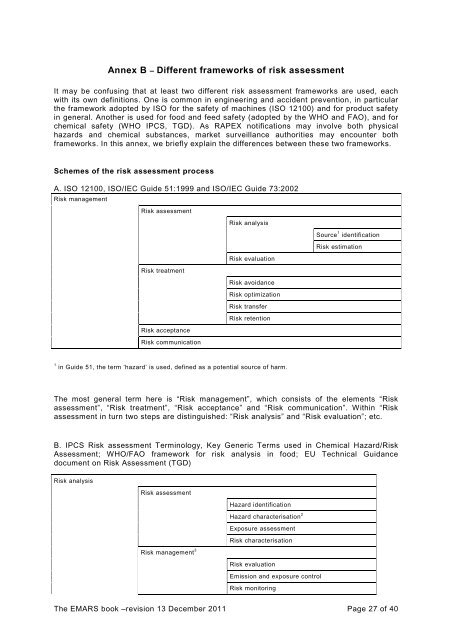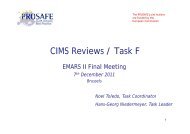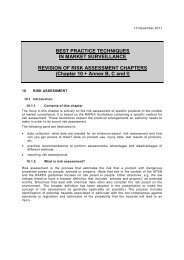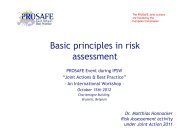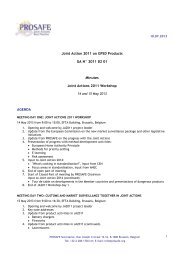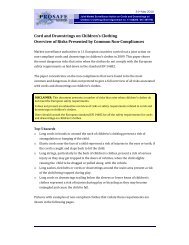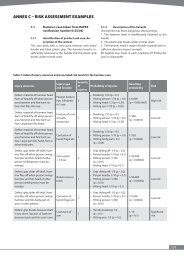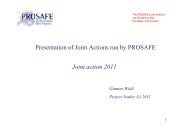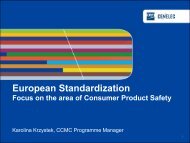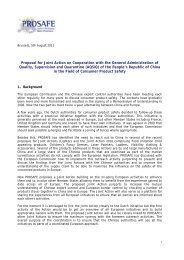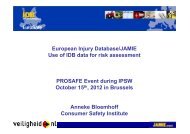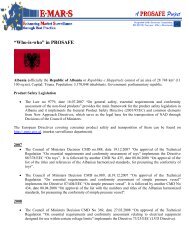Annex B- Different Frameworks of Risk Assessment - Prosafe
Annex B- Different Frameworks of Risk Assessment - Prosafe
Annex B- Different Frameworks of Risk Assessment - Prosafe
You also want an ePaper? Increase the reach of your titles
YUMPU automatically turns print PDFs into web optimized ePapers that Google loves.
<strong>Annex</strong> B – <strong>Different</strong> frameworks <strong>of</strong> risk assessment<br />
It may be confusing that at least two different risk assessment frameworks are used, each<br />
with its own definitions. One is common in engineering and accident prevention, in particular<br />
the framework adopted by ISO for the safety <strong>of</strong> machines (ISO 12100) and for product safety<br />
in general. Another is used for food and feed safety (adopted by the WHO and FAO), and for<br />
chemical safety (WHO IPCS, TGD). As RAPEX notifications may involve both physical<br />
hazards and chemical substances, market surveillance authorities may encounter both<br />
frameworks. In this annex, we briefly explain the differences between these two frameworks.<br />
Schemes <strong>of</strong> the risk assessment process<br />
A. ISO 12100, ISO/IEC Guide 51:1999 and ISO/IEC Guide 73:2002<br />
<strong>Risk</strong> management<br />
<strong>Risk</strong> assessment<br />
<strong>Risk</strong> analysis<br />
<strong>Risk</strong> evaluation<br />
<strong>Risk</strong> treatment<br />
<strong>Risk</strong> avoidance<br />
<strong>Risk</strong> optimization<br />
<strong>Risk</strong> transfer<br />
<strong>Risk</strong> retention<br />
<strong>Risk</strong> acceptance<br />
<strong>Risk</strong> communication<br />
Source 1 identification<br />
<strong>Risk</strong> estimation<br />
1 in Guide 51, the term ‘hazard’ is used, defined as a potential source <strong>of</strong> harm.<br />
The most general term here is “<strong>Risk</strong> management”, which consists <strong>of</strong> the elements “<strong>Risk</strong><br />
assessment”, “<strong>Risk</strong> treatment”, “<strong>Risk</strong> acceptance” and “<strong>Risk</strong> communication”. Within “<strong>Risk</strong><br />
assessment in turn two steps are distinguished: “<strong>Risk</strong> analysis” and “<strong>Risk</strong> evaluation”; etc.<br />
B. IPCS <strong>Risk</strong> assessment Terminology, Key Generic Terms used in Chemical Hazard/<strong>Risk</strong><br />
<strong>Assessment</strong>; WHO/FAO framework for risk analysis in food; EU Technical Guidance<br />
document on <strong>Risk</strong> <strong>Assessment</strong> (TGD)<br />
<strong>Risk</strong> analysis<br />
<strong>Risk</strong> assessment<br />
Hazard identification<br />
Hazard characterisation 2<br />
Exposure assessment<br />
<strong>Risk</strong> characterisation<br />
<strong>Risk</strong> management 3<br />
<strong>Risk</strong> evaluation<br />
Emission and exposure control<br />
<strong>Risk</strong> monitoring<br />
The EMARS book –revision 13 December 2011 Page 27 <strong>of</strong> 40
<strong>Risk</strong> communication<br />
Interactive exchange <strong>of</strong> information about risks<br />
2 includes dose-response assessment; TGD uses ‘effects assessment’ as an overall term for hazard identification<br />
and dose-response assessment<br />
3<br />
WHO/FAO have four components here: preliminary risk management activities; evaluation <strong>of</strong> risk management<br />
options; implementation <strong>of</strong> risk management decision; monitoring and review.<br />
Here, the general term is “<strong>Risk</strong> analysis” consisting <strong>of</strong> the activities “<strong>Risk</strong> assessment”, “<strong>Risk</strong><br />
management” and “<strong>Risk</strong> communication”; etc.<br />
Due to the different ways <strong>of</strong> dividing the process, it is not possible to simply make a<br />
correlation table to translate terms. For example, the ISO/IEC term risk estimation is more or<br />
less a combination <strong>of</strong> hazard characterisation and exposure assessment. <strong>Risk</strong> evaluation in<br />
the ISO/IEC framework can be compared with risk characterisation combined with risk<br />
evaluation in the IPCS terminology.<br />
The following definitions are used in the IPCS document:<br />
<strong>Risk</strong><br />
The probability <strong>of</strong> an adverse effect in an organism caused under specified circumstances by<br />
exposure to an agent.<br />
Agent<br />
Chemical substance, which may cause adverse effects such as injury or damage to health.<br />
NOTE: in this definition, we extend the meaning <strong>of</strong> ‘agent’ from chemical substance to include<br />
physical hazards]<br />
<strong>Risk</strong> assessment<br />
A process intended to calculate or estimate the risk to a given target organism, including the<br />
identification <strong>of</strong> attendant uncertainties, following exposure to a particular agent, taking into<br />
account the inherent characteristics <strong>of</strong> the agent <strong>of</strong> concern as well as the characteristics <strong>of</strong><br />
the specific target organism.<br />
The risk assessment process includes four steps: hazard identification, hazard<br />
characterization, exposure assessment, and risk characterization.<br />
Hazard identification<br />
The identification <strong>of</strong> the type and nature <strong>of</strong> adverse effects that an agent has an inherent<br />
capacity to cause in an organism, system, or (sub) population.<br />
NOTE: the result <strong>of</strong> this step should be a number <strong>of</strong> scenarios that may occur including the health outcomes<br />
(endpoints).<br />
Hazard characterisation<br />
The qualitative and, wherever possible, quantitative description <strong>of</strong> the inherent property <strong>of</strong> an<br />
agent or situation having the potential to cause adverse effects. This should, where possible,<br />
include a dose–response assessment and its attendant uncertainties.<br />
NOTE: the result <strong>of</strong> this step should be a justified conclusion about the severity <strong>of</strong> the adverse<br />
effects. The tool used fort this in the RAPEX Guidelines is the injury table.<br />
The EMARS book –revision 13 December 2011 Page 28 <strong>of</strong> 40
Exposure assessment<br />
Evaluation <strong>of</strong> the exposure <strong>of</strong> an organism, system, or (sub)population to an agent.<br />
NOTE: General relevant parameters are frequency <strong>of</strong> contact with the product, exposure<br />
pathways, behaviour <strong>of</strong> person and vulnerability <strong>of</strong> person.<br />
For chemical substances, exposure is usually expressed as mg substance per kg body weight<br />
that is taken up by inhalation, dermal contact or ingestion; specific parameters include e.g.<br />
evaporation or diffusion.<br />
For physical hazards, relevant parameters can be the probability that a scenario will occur,<br />
energy transferred to a body part, etc.<br />
<strong>Risk</strong> characterisation<br />
The qualitative and, wherever possible, quantitative determination, including attendant<br />
uncertainties, <strong>of</strong> the probability <strong>of</strong> occurrence <strong>of</strong> known and potential adverse effects <strong>of</strong> an<br />
agent in a given organism, system, or (sub)population, under defined exposure conditions.<br />
NOTE: the result <strong>of</strong> this phase is a conclusion on the expected risk level in terms <strong>of</strong> severity<br />
and probability. It may include a quantitative probability distribution <strong>of</strong> adverse effects, and<br />
confidence intervals or sensitivity analysis.<br />
The EMARS book –revision 13 December 2011 Page 29 <strong>of</strong> 40


